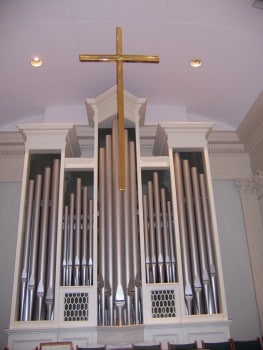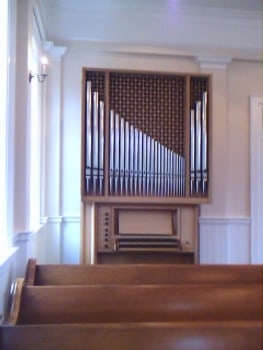Our Organs
The Moeller Organ
Written by Steven Newberry; edited by Randall Sheets

Our pipe organ was built in 1989 by the Moeller Company. With its specification drawn by the music director at that time, Steven Newberry, its 18 ranks on two manuals and pedal work beautifully in the sanctuary acoustics designed by Klepper. The instrument has the advantage of ideal placement, singing from its casework housed inside the sanctuary itself, rather than from chambers outside the room. The instrument works well as a leader of congregational song, as an accompanist of choirs and instruments, and as a recital instrument.
The visual appearance of the organ was carefully designed to complement its setting and required close cooperation between the church’s architect and the builder. Prior to the 1950’s most organs in this country were designed in such a way that the congregation did not see actual “speaking” pipes which were either screened from view by purely decorative pipes which produced no sound or were totally hidden from view in chambers, as was the case with our former instrument. During the intervening years many organ builders and architects discovered that by returning to the unenclosed feature of the baroque organ, they could achieve stunning musical and visual effects. Our new organ was designed in this fashion. All the pipes, which the congregation sees, are “speaking” pipes.
The heart of the organ is constituted by its 1,103 pipes which are arranged in 18 ranks with each rank requiring 61 separate pipes to cover a five octave range. Pedal ranks, which produce the organ’s lowest notes, normally have thirty-two pipes covering two and one-half octaves.
Each division has its own ranks of pipes which belong to four “families”: flutes, strings, reeds, and principal. The distinctive pipe organ sound which cannot be duplicated by any other instrument is produced by ranks designated as the Principal. While some stops are named after instruments of the orchestra, they do not try to simulate the precise sound of a given instrument.
The names of the various stops are given in the technical specifications of the organ. The Arabic numbers printed with the name of a stop refers to the length, in feet, of the pipe producing the lowest note in that given stop. The pitch produced by a pipe is determined by its length. Halving the length of a pipe produces a pitch one octave higher. Thus the lowest note of an eight foot rank is produced by a pipe eight feet long while the highest note of an eight foot rank is produced by a six inch pipe.
Roman numerals included with the name of a stop indicate how many ranks are controlled by a given drawknob. For example, when the organist pulls the knob for the stop designated “Sesquialtera,” two pipes sound simultaneously since this stop is constituted by two ranks of pipes.
Specifications of Moller Opus 11,779
Spring Hill Presbyterian Church
Mobile, Alabama
Manuals: Compass CC to C4, 61 notes
Pedals: Compass CCC to G, 32 notes
Action: Electro-Pneumatic
Console: Detached. Stops and intra-manual couplers controlled by walnut with maple inset drawknobs, inter-manual couplers controlled by maple tilting tablets. Natural manual keys are of bone, with walnut sharps. Pedal sharps are walnut with maple naturals.
Pitch: A-440
Crescendo Pedal and Swell Expression Pedal
Combination Action: Solid State, quad-memory (capture action and setter button)
12 generals (thumb pistons and toe studs)
8 pistons per divison (manual division thumb pistons; pedal toe studs)
Reversible toe studs: swell to pedal, great to pedal, 32′ reed cornet, 32′ resultant, zimbelstern
Tutti (reversible thumb piston and toe stud)
GREAT ORGAN (unenclosed)
16′ Bourdon (61 pipes)
8′ Principal (61 pipes)
8′ Gedeckt (12 pipes; extension of Bourdon)
4′ Octave (61 pipes)
4′ Koppelflote (61 pipes)
2′ Super Octave (24 pipes; extension of Principal)
2′ Flute (24 pipes; extension of Bourdon)
II Sesquialtera (Tenor C; 98 pipes)
III-IV Mixture (208 pipes)
8′ Trompete (from Swell)
Chimes (25 chimes- G2-G4)
Zimbelstern
Tremulant
SWELL ORGAN (under expression)
8′ Spitzprincipal (61 pipes)
8′ Rohrflote (61 pipes)
8′ Gemshorn (61 pipes)
8′ Gemshorn Celeste (Tenor C; 49 pipes)
4′ Spitzoctave (12 pipes; extension of 8′ Spitzprincipal)
4′ Rohrflote (12 pipes; extension of 8′ Rohrflote)
2 2/3′ Nazard (61 pipes)
2′ Principal (12 pipes; extension of 8′ Spitzprincipal)
1 1/3′ Larigot (19 pipes; extension of gemshorn)
1′ Octave (12 pipes; extension of Spitzprincipal)
16′ Contre Trompette (61 pipes)
8′ Trompette (12 pipes; extension of Contre Trompette)
4′ Clairon (12 pipes; extension of Contre Trompette)
Tremulant
16′ Festival Trumpet (not under expression; 49 pipes; Tenor C)
8’Festival Trumpet (12 pipes; extended from 16′ Festival Trumpet)
PEDAL ORGAN
32′ Resultant
16′ Contre Bass (32 pipes)
16′ Bourdon (from Great Bourdon)
8′ Principal (12 pipes; extension of Contre Bass)
4′ Choral Bass (12 pipes; extension of Contre Bass)
4′ Flute (from Great Bourdon)
III Mixture (24 pipes)
32′ Reed Cornet(from Bourdon and Contre Trompette)
16′ Contre Trompette (from Swell)
8′ Trompette (from Swell)
4’Clairon (from Swell)
COUPLERS
Great to Pedal 8
Swell to Pedal 8
Swell to Great 8
Swell to Great 4
Swell Unison Off
Swell 4
Great to Swell 8
Great Unison Off

This mechanical action pipe organ, built by the Heissler company of Germany,was installed in our Memorial Chapel in January 2011. The instrument is one of their Mädelhofen line of instruments.
Manual compass: C-f3 (54 notes)
Pedal compass: C-d1 (27 notes)
Slider Chest with mechanical key and stop action
Manual I
1. Rohrflöte 8′ (1-15 wood; 16-54 30% Tin)
2. Principal 4′ (75% Tin)
3. Mixtur 1 1/3′ (2 ranks; 63% Tin)
Manual II
4. Gedact 8′ (pipes 1-15 from Rohrflöte 8′; 16-54 30% Tin)
5. Rohrflöte 4′ (30% Tin)
6. Waldflöte 2′ (40% Tin)
Pedal
7. Subbass 16′ (Wood)
Couplers
Manual II – Manual I
Manual II – Pedal
Manual I – Pedal
Dimensions
Height 3.08 meters
Width 1.69 meters
Depth (with bench and pedalboard)1.83 metersontent
